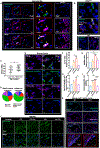Olfactory receptor 2 in vascular macrophages drives atherosclerosis by NLRP3-dependent IL-1 production
- PMID: 35025664
- PMCID: PMC9744443
- DOI: 10.1126/science.abg3067
Olfactory receptor 2 in vascular macrophages drives atherosclerosis by NLRP3-dependent IL-1 production
Abstract
Atherosclerosis is an inflammatory disease of the artery walls and involves immune cells such as macrophages. Olfactory receptors (OLFRs) are G protein–coupled chemoreceptors that have a central role in detecting odorants and the sense of smell. We found that mouse vascular macrophages express the olfactory receptor Olfr2 and all associated trafficking and signaling molecules. Olfr2 detects the compound octanal, which activates the NLR family pyrin domain containing 3 (NLRP3) inflammasome and induces interleukin-1β secretion in human and mouse macrophages. We found that human and mouse blood plasma contains octanal, a product of lipid peroxidation, at concentrations sufficient to activate Olfr2 and the human ortholog olfactory receptor 6A2 (OR6A2). Boosting octanal levels exacerbated atherosclerosis, whereas genetic targeting of Olfr2 in mice significantly reduced atherosclerotic plaques. Our findings suggest that inhibiting OR6A2 may provide a promising strategy to prevent and treat atherosclerosis.
Figures




Comment in
-
The scent of atherosclerosis.Science. 2022 Jan 14;375(6577):145-146. doi: 10.1126/science.abn4708. Epub 2022 Jan 13. Science. 2022. PMID: 35025639
-
Macrophage OLFR2 activation is atherogenic.Nat Rev Cardiol. 2022 Mar;19(3):147. doi: 10.1038/s41569-022-00674-0. Nat Rev Cardiol. 2022. PMID: 35079156 No abstract available.
-
Vascular macrophages sense octanal and drive athero-inflammation.Cell Mol Immunol. 2022 Oct;19(10):1077-1078. doi: 10.1038/s41423-022-00896-9. Epub 2022 Jul 4. Cell Mol Immunol. 2022. PMID: 35788170 Free PMC article. No abstract available.
-
Olfactory receptor 2 activation in macrophages: novel mediator of atherosclerosis progression.Signal Transduct Target Ther. 2022 Jul 21;7(1):247. doi: 10.1038/s41392-022-01115-7. Signal Transduct Target Ther. 2022. PMID: 35864109 Free PMC article. No abstract available.
References
Publication types
MeSH terms
Substances
Grants and funding
- R01 DK106000/DK/NIDDK NIH HHS/United States
- S10 RR027366/RR/NCRR NIH HHS/United States
- 18CDA34110426/AHA/American Heart Association-American Stroke Association/United States
- R01 HL126827/HL/NHLBI NIH HHS/United States
- R01 HL115232/HL/NHLBI NIH HHS/United States
- S10 OD021831/OD/NIH HHS/United States
- R01 HL130819/HL/NHLBI NIH HHS/United States
- P01 HL088093/HL/NHLBI NIH HHS/United States
- R01 HL145454/HL/NHLBI NIH HHS/United States
- R01 HL103866/HL/NHLBI NIH HHS/United States
- P01 HL136275/HL/NHLBI NIH HHS/United States
- 18POST34060251/AHA/American Heart Association-American Stroke Association/United States
- P30 DK120515/DK/NIDDK NIH HHS/United States
- R35 HL145241/HL/NHLBI NIH HHS/United States
LinkOut - more resources
Full Text Sources
Other Literature Sources
Medical
Molecular Biology Databases

